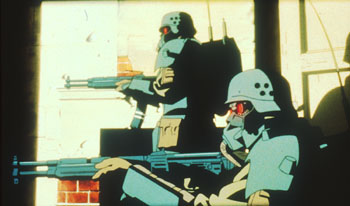![[Metroactive Movies]](/movies/gifs/movies468.gif)
[ Movies Index | Show Times | San Jose | Metroactive Central | Archives ]
Anime In the 'Hood
'Jin-Roh' retells Little Red Riding Hood story in war of fascists and radicals
By Jim Aquino
IF BRIAN DE PALMA ever made an anime feature, it would probably resemble director Hiroyuki Okiura's somber and visually striking thriller Jin-Roh: The Wolf Brigade, which deals with De Palma's most frequent theme, the anguish of a man (in this case, a young Tokyo cop) unable to prevent the deaths of others. (Also, like much of De Palma's work, Jin-Roh is pretty rough in the violence department.)
The film's setting is an unusual one: an alternative-reality Tokyo, occupied by Nazi Germany during "The Great Defeat," as explained in a rather clunky and overloaded opening narration sequence, the film's biggest misstep. (The alternative Tokyo, a mix of Teutonic and postwar Japanese architectural styles, is cleverly designed by art director Hiromasa Ogura.) After the occupation troops left the city, a radical terrorist group known as the Sect rose to power and began rioting in the streets, and the fascist government responded by beefing up the manpower and firepower of its heavily armored, red goggle-eyed and quite eerie-looking Special Unit paramilitary police force.
During a nighttime melee in the city's sewers, a Special Unit rookie named Fuse (pronounced "foo-say") corners one of the Sect's "little red riding hoods" (teenage girls hired by the Sect to deliver bombs) but hesitates to shoot her. The frightened teen decides to kill herself and detonates her bomb, knocking out half the city's electricity in the process. Fuse survives the blast but is emotionally scarred, constantly having nightmares about her death. Investigated by his superiors, Fuse launches an investigation of his own, seeking out the girl's identity. During his search, he meets the girl's older sister, Kei, who physically resembles the victim, and falls in love with her.
Kei also begins appearing in one of Fuse's recurring nightmares, in which a pack of wolves eats her alive. Is Kei leading a double life as a "riding hood"? Who are the wolves in Fuse's dreams? What's up with all the riding hood/wolf analogies? It turns out that Jin-Roh (in English, the title translates as "man-wolf") is essentially a contemporary retelling of Rötkappchen, the original--and much grislier--Brothers Grimm version of Little Red Riding Hood, in much the same way the Tristan legend served as the basis for Vertigo, which Jin-Roh also recalls.
The screenplay, by Mamoru Oshii, the writer/director of the 1995 cyberpunk anime hit Ghost in the Shell, is a cut above the cheesecake-and-carnage schlockiness of most animes released in America. The pensive tone of the material is rare, even in Hollywood live-action fare these days. Too bad the dialogue often sounds as stilted as it did in the overpraised Ghost in the Shell. The lofty existentialist ruminations Oshii writes for his characters were made for subtitling, not indifferently dubbed English.
[ San Jose | Metroactive Central | Archives ]
![]()

Future Fear: Fascist troops rule an alternative-reality Tokyo in the future world of 'Jin-Roh: The Wolf Brigade.'
Jin-Roh: The Wolf Brigade (Unrated; 98 min.), directed by Hiroyuki Okiura, written by Mamoru Oshii and photographed by Hisao Shirai, opens Friday at the Towne Theater in San Jose.
From the July 26-August 1, 2001 issue of Metro, Silicon Valley's Weekly Newspaper.